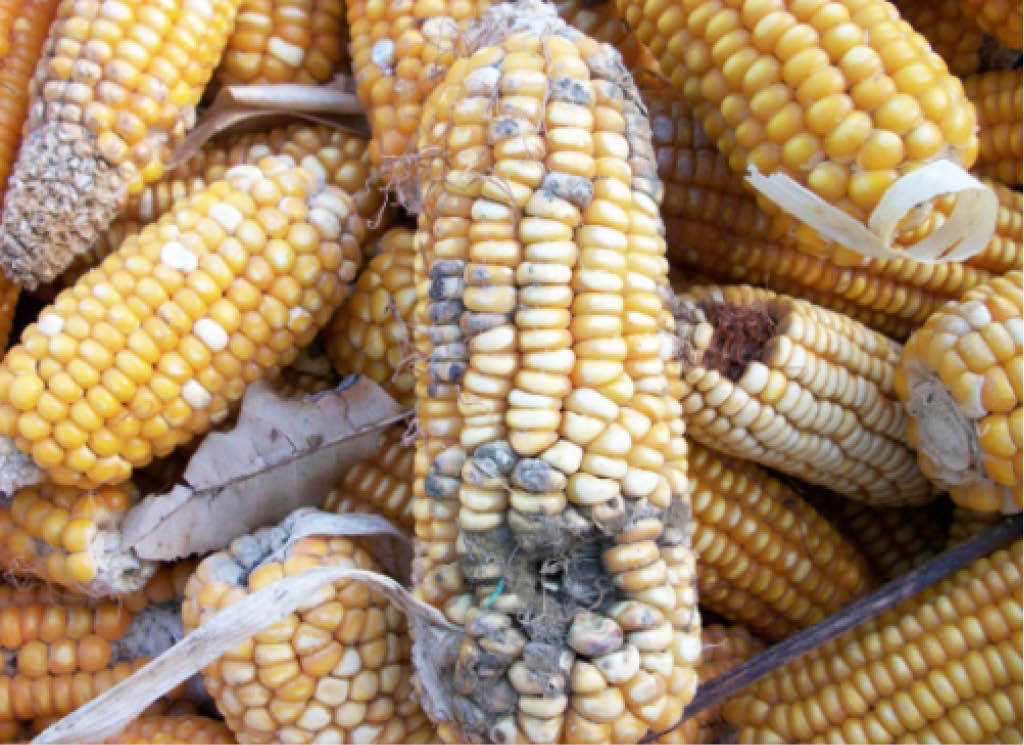Stakeholders in the agricultural sector are cautioning maize farmers on aflatoxin bacteria in their produce, saying there is reported rise in infection in locally grown maize.
Aflatoxins are naturally occurring toxins produced by the fungus, Aspergillus flavus.
The fungi can be recognised by gray-green or yellow-green moulds growing on corn kernels in the field or in storage.
They are poisonous carcinogens and mutagens that are produced by certain moulds which grow in soil, decaying vegetation, hay and grains.
An agriculture expert, Mr. Ismail Olawale, recently raised alarm on the increasing rate of aflatoxin infection in locally grown maize.
Mr. Olawale, a fellow at the Nigerian Agriculture and Extension Liaison Services (NAERLS), Zaria, raised the alarm in an interview in Lagos.
The expert said research had shown that the presence of aflatoxin in locally cultivated maize and its subsequent consumption had led to certain illnesses and early mortality.
He said, “We have to consider the issue of aflatoxin bacteria found in locally produced maize. It usually affects the maize through the soil.
“An academic research by post-graduate students of the University of Ibadan (UI) in an area in Ekiti State discovered that early mortality in the area was closely linked to aflatoxin bacteria found in corn pap they consume regularly.
“From researches, it has been discovered that the accumulation of aflatoxin bacteria in local maize can lead to life-threatening illnesses and diseases.
“According to the researchers, the aflatoxin bacteria found in maize does not result in immediate death, but their accumulation in the body can lead to major illnesses and early mortality in the long-run.”
Olawale, therefore, advised local farmers to carefully pick out infected maize cobs and discard them so that people do not get to consume them.
Mr. Gideon Matthew, an agriculturist and maize farmer, called for an upgrade in the standard and quality of locally grown maize to forestall the recurrence of aflatoxin infections.
Mr. Matthew said plants stress due to drought, heat or insect damage during fungi growth usually increased aflatoxin levels.
He said aflatoxin contamination problems were minimised with management such as thorough grain cleaning, proper combine adjustment to reduce kernel damage, matching drying capacity to wet corn holding capacity, proper drying, removal of fines and broken kernels, proper grain cooling after drying and sound storage practices.
He added that in sorting out locally produced maize, most of local farmers usually did not take out the black or brown seeds affected by aflatoxin in a bid to make more profit.
He explained that, “Our local farmers should be educated to take out maize cobs infected by the aflatoxin bacteria in order to improve the quality of the produce they release to the final consumers.
“In cases where the farmers sort out the aflatoxin-infected maize, some of them feed it to poultry and other livestock which also negatively affects the animals.”
Mr. Matthew, therefore, advised that, “We need to step up the quality of maize grown locally so as to reduce the rate of aflatoxin bacteria and subsequent illnesses in humans.”
A medical doctor, Dr. Kayode Olajide, warned that chronic exposure to aflatoxin was associated with increased risk of developing liver cancer, impaired immune function and malnutrition.
Dr. Olajide advised consumers of maize, rice and other grains that are vulnerable to aflatoxin bacteria attack, to always pick out the affected produce before consuming it.
What farmers should do to check infection
Aflatoxin contamination can reduce feeding value and hinders sales, thus farmers are advised to take the following steps to reduce infection:
- Sanitation of equipment is the first step in preventing post-harvest aflatoxin contamination. Clean out all harvesting, handling and drying equipment and storage bins prior to harvest.
- Farmers are advised to remove all broken corn, dust and foreign material that can provide a source of contamination.
- Check and repair storage bins to prevent moisture and leaks from faulty joints or other problems.
In addition, Mr. Ismail Olawale, an agriculturist, called for more local researches to discover the origin of the bacteria and curb its spread.
Mr, Olawale said, “There is a discovery of anti-aflatoxin by the International Institute of Tropical Agriculture (IITA), Ibadan, to reduce the rate of aflatoxin infection in locally grown maize.
“My take is that if we have local research to curb aflatoxin infection of our maize, let us also discover the origin of the disease and educate farmers on it.
“Aflatoxin was not always seen in our locally grown maize, it could have come into existence as a result of the use of herbicides or other chemical additives in the cultivation process. Once we discover the cause of the aflatoxin bacteria, then we will discover the solution to curbing the bacteria.”




